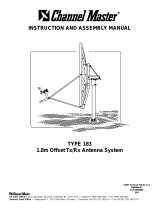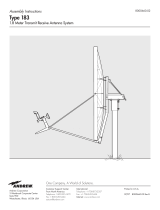Page is loading ...

i
Contents
H3C ANT-5029D-M2 dish antenna installation guide ····························································································· 1
Technical specifications ···················································································································································· 1
Safety precautions ····························································································································································· 3
Installation guidelines ······················································································································································· 3
Choosing a mounting location ········································································································································ 4
Mounting the antenna ······················································································································································ 4
Tools and equipment required ································································································································ 4
Mounting the antenna on a mast ···························································································································· 5
Recommended cable ················································································································································ 6

Manual Version:5PW100-20120627
1
H3C ANT-5029D-M2 dish antenna installation
guide
Technical specifications
The ANT-5029D-M2 antenna is designed for use in outdoor environments. It is connected to the 5-GHz
antenna port on an H3C outdoor AP through an N-type connector.
Figure 1 Antenna view
Table 1 Technical specifications
Antenna type ANT-5029D-M2
Operating frequency range 5150 MHz to 5850 MHz
Bandwidth 700 MHz
Peak gain 28.5 dBi
Front to Back Ratio ≥ 35 dB
Horizontal beamwidth 5°C
Vertical beamwidth 5°C
Voltage standing wave ratio (VSWR) ≤ 1.5
Impedance 50 Ω
Polarization type Vertical or horizontal
Max. power 100 W
Connector N-Female
Dimensions 600 mm (23.62 in) in diameter

Manual Version:5PW100-20120627
3
Figure 3 Vertical pattern
Safety precautions
W
ARNING!
• Installing antennas is dangerous. For your safety, follow the installation directions.
• Keep the antenna away from power source, street lamps, distribution box, or other places that may
cause power shock.
• Do not touch any power lines for your safety.
• Keep safety in mind when you select your installation site. Keep the antenna away from electric
power lines and other lines.
• Do not work alone when you install the antenna.
• If you need to raise the mast, work with other people to avoid bodily injury.
• Do not use a metal ladder. Do not work on a wet or windy day. Dress properly, for example, shoes
with rubber soles. Wear rubber gloves.
• If the antenna, antenna cable, or any other installation accessory drops, get away from it to avoid
bodily injury.
• If an accident, for example, electrical shock, occurs with the power lines, immediately call for
qualified emergency help.
Installation guidelines
To ensure the best possible performance of the antenna, follow these guidelines:
1. Install the antenna vertically and make sure the antenna bottom faces downwards.

Manual Version:5PW100-20120627
4
2. Keep the antenna away from metal obstructions such as heating and air-conditioning ducts.
3. The density of the wall materials determines the number of walls signals can pass through and still
ensure data communication. Consider the following before choosing the location to install the
antenna:
{ Signals can penetrate vinyl and paper walls with little affect to signal strength.
{ Signals can penetrate one or two solid or pre-cast concrete walls with signal strength not
degraded.
{ Signals can penetrate three or four concrete walls with signal strength not degraded.
{ Signals can penetrate five or six wood walls with signal strength not degraded.
{ Signals cannot penetrate a metal wall even if the metal covering is very thin.
{ Signals cannot penetrate a wire mesh spaced between 2 and 3 cm (0.79 and 1.18 in).
4. Keep the antenna away from microwave ovens and 2-GHz wireless phones, because they operate
in the same frequency range as the device to which your antenna is connected and can cause
signal interference.
Choosing a mounting location
To achieve best possible performance, install the antenna as high as possible, such as building top,
mountain top, and tower top. In addition, mount the antenna clear of any metal obstructions to the sides
of the radiating element, and use a cable as short as possible to connect the antenna and AP.
Mounting the antenna
You can install the ANT-5029D-M2 antenna on a mast. The installation accessories are provided
(installation tools are user provided). If you intend to install your antenna on another surface, you must
provide the appropriate installation accessories.
Tools and equipment required
Provided with the antenna:
• One reflector mounting bracket
• Two U-bolts, each of which consists of one U-bolt, two M10 hex nuts, two flat washers, and two
spring washers.
• One assistant clamp, consisting of one U-mounting bracket, one M10 U-bolt, and two sets of M10
nuts, flat washers, and spring washers
• One M16 adjustment bolt containing two sets of M16 nuts, flat washers, and spring washers
• Three 10 mm (0.39 in) diameter and 25 mm (0.98 in) length screws
• Three 10 mm (0.39 in) diameter nuts/flat washers/spring washers
• Four 4 mm (0.16 in) diameter and 10 mm (0.39 in) length screws
• Four 4 mm (0.16 in) diameter nuts/flat washers/spring washers
User-supplied:
• One adjustable wrench
• One mast with a diameter of 40 to 70 mm (1.57 to 2.76 in)

Manual Version:5PW100-20120627
5
Mounting the antenna on a mast
To mount the antenna on a mast:
1. Use four 4 mm (0.16 in) diameter nuts, and corresponding flat washers and spring washers to
attach the feeder to the mounting holes on the reflector. See Figure 4.
2. Use three 10 mm (0.39 in) diameter nuts and corresponding flat washers and spring washers to
mount the reflector mounting bracket and adjustment bolt to the mounting holes at the rear of the
reflector.
3. Attach the assistant clamp to the mast.
Bolts and nuts are available on the assistant clamp.
4. Mount the reflector mounting bracket to the mast, making sure the bracket sits on the support
bracket.
5. Check that the polarization sign on the reflector is point to the right direction.
6. Rotate the antenna around the mast and adjust the adjustment clamp to obtain the maximum signal
strength.
7. Fasten all screws.
8. Connect the antenna connector to the antenna cable.
9. Weatherproof the connector with sealant tape.
Figure 4 Mounting the antenna to a mast
(1) M16 adjustment
bolt (2)
Reflector
mountin
g
bracket
(3)
A
djustment clamp
(4) Connector (5)
Feeder lockin
g
screws
(6)
Reflector
(7) Feeder

Manual Version:5PW100-20120627
6
Recommended cable
H3C recommends that you use a high-quality, low-loss cable with the antenna. Coaxial cable loses
efficiency as the frequency increases, causing signal loss. Keep the cable as short as possible because
cable length also causes signal loss (the longer the run, the greater the loss).
/


